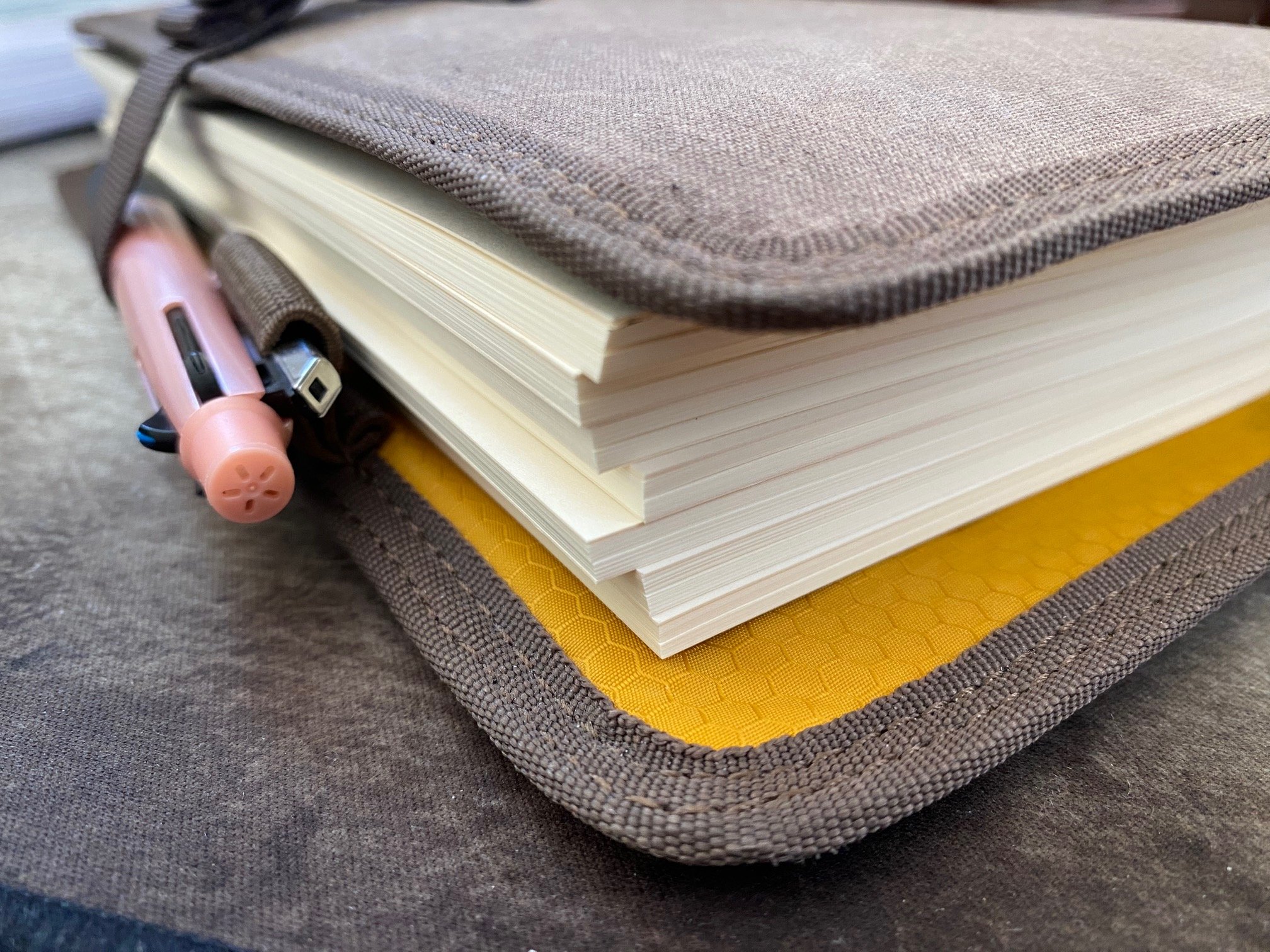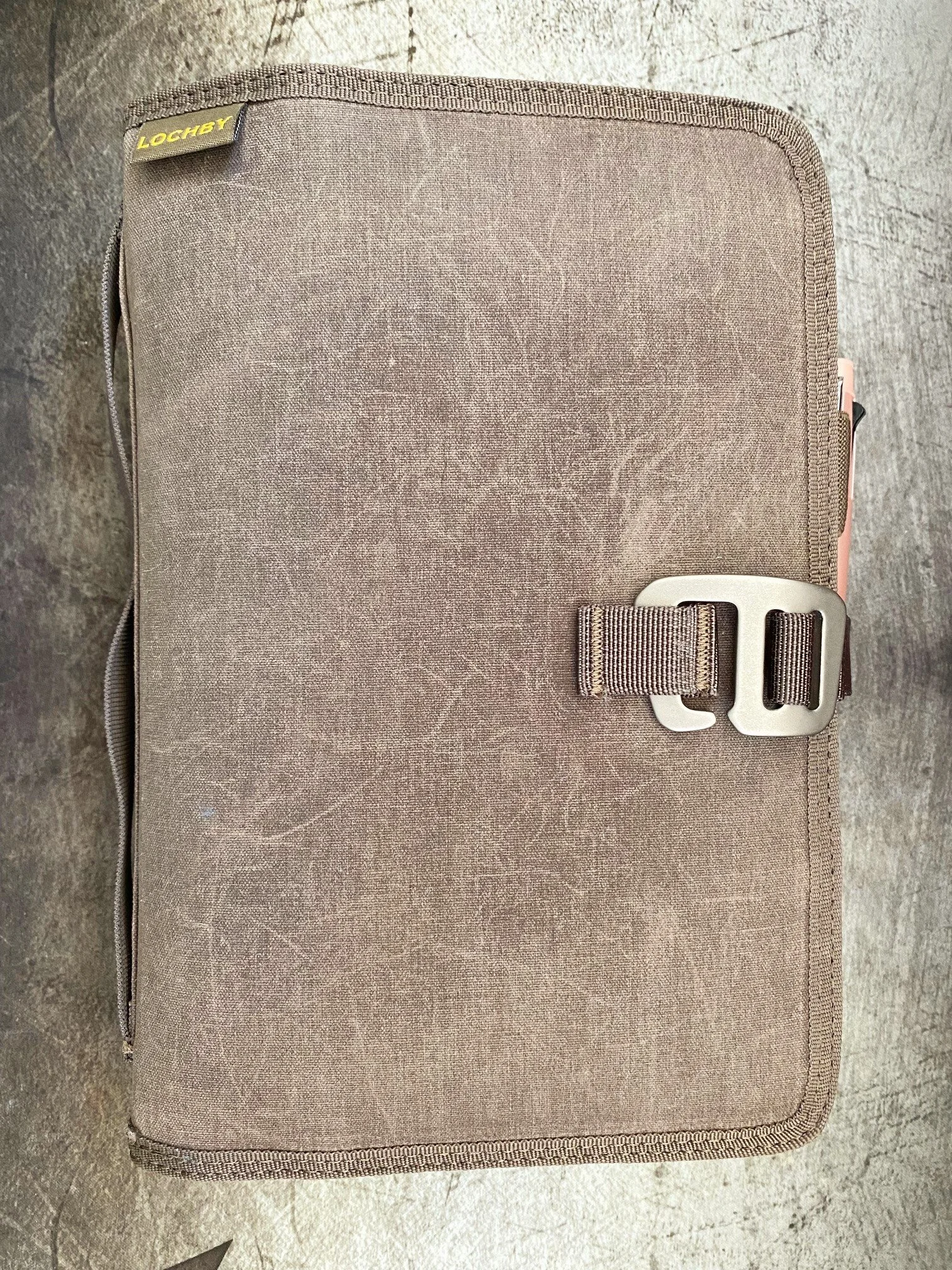(Sarah Read is an author, editor, yarn artist, and pen/paper/ink addict. You can find more about her at her website and on Twitter. And check out her latest book, Out of Water, now available where books are sold!)
Last week I reviewed the Midori MD 70th Anniversary set of seven notebooks and I had a lot of fun thinking about all the ways I could put them to good use. I knew I didn't want to split up the set--the rainbow stitching is everything! Normally I'd use them for school, but I'm in my last two classes now--there are no future semesters to save them for! But the thing I'm most excited about being done with school is returning to full-time writing.
Being an author really means running a small business and there can be a lot to keep track of. I have, in the past, used one notebook to track all my writerly business, but they fill up fast when you're keeping busy. Enter a big set of seven lovely notebooks...
Also enter the fabulous Lochby Field Journal, which is robust enough to contain this ambitious plan.
I assigned each of the notebooks to a different aspect of writerly business: Deadline and submission tracking, listing and outlining ideas, jotting down bits of story drafts, making notes about critiques and edits, listing publication and contract details, notes about the craft of writing, and keeping track of the classes I teach or readings/signings, etc.
Keeping track of deadlines is important for obvious reasons, but it will be helpful to keep them listed in one place, alongside due dates for other open calls for submissions that look interesting. That way I can glance at that list and make a more informed decision about how busy I am when I'm approached for a project. Since many deadlines can be six months to a year out, tracking them on a calendar isn't a good way to get an overview. This way I'll have a list I can reference to confirm that I should definitely not take on any more work in the month of April! I can also keep track of where I send work and when. Some publishers don't send rejections--you're meant to assume you were rejected after not hearing back after a certain amount of time passes, so it's important to know when that time is. Most publishers also don't allow you to submit the same work more than once, so it's crucial to keep track of where you've sent each piece.
Keeping track of ideas is also important. Ideas are everywhere, and some are more demanding than others. Sometimes a good idea tries to butt in when I'm working on something else that has a due date and I don't have time to set it aside to focus on the shiny new idea. I've always kept an idea notebook, so this isn't a new one for me, but hopefully this will help me keep them in better order. They do tend to show up on the backs of receipts or scribbled in the margins of school notes. Sometimes I need a place to just jot down a single-sentence concept, and sometimes I need to write the whole outline. This book will hold both/either.
If whole sections of a story jump into my head, but they aren't ready to be fully written yet, I need a place to write down that bit until I'm ready for it. That will go in the next notebook, Draft Bits. Stories often come to me out of order, so this is a place where I can write scenes down when I need to come back to them.
I am part of a monthly critique group, as well as a more sporadic workshop, so I need a place to write down the feedback I receive on my work, as well as any ideas I have for edits to a piece. The Critique and Edit Notes notebook will be the home for that info.
Publication information goes in the next one. This is where I'll keep track of contract terms (Do I retain audio rights to this story or does the publisher? When does the exclusive printing period end? Is it a flat rate payment or are their royalties to track?). This way I won't have to go combing through contract files every time I want to reprint a piece.
In the next notebook, I'll record bits of wisdom about the craft of writing. When I attend panels or author talks, I like to write down anything educational or interesting, or notes about what particular editors are looking for in work submitted to them.
In the last notebook, I'll keep track of my own gigs--when I lead workshops or teach classes, do readings, speak on panels, do interviews, or appear on podcasts. I haven't always been good at tracking that, and then a friend mentioned how important that info is for a potential CV if I ever want to get a teaching job or archive my work. This will give me a good way to plan for and track all those appearances.
To cram all this content into one notebook cover, I used skills gleaned from Traveler's Notebook journalers. I used sewing thread (because that's what I had--I'll get elastics eventually) to tie notebooks 1 and 3 together, with the back cover of 1 and the front cover of 3 facing each other. Then I slid notebook 1 through the first elastic on the Lochby so that the elastic fit between the two notebooks, holding them by the threads. Then I slid notebook 2 through that same elastic at its halfway point. I repeated that process by tying notebooks 4 and 6 together, sliding them though another elastic, and then putting notebook five on that same elastic between them. Notebook 7 is on its own elastic at the end. They all fit quite well! There's enough movement that each notebook is still easy to write in, and there's even still room for me to stuff a bunch of writing note scraps in the pockets of the notebook cover. The thick spine and adjustable clasp on the Lochby are my friend, here.
I'm eagerly anticipating the shift from writing research papers to writing more stories and novels. I've still written a handful, but not nearly as much as I want. For the past two years, the notebook that's been filling up fastest is the one where I list all the ideas I don't have time to write. I'm excited to start filling up all these notebooks, replacing the inserts, and filling those up, too. 93 more days. (In fact, my last ever day of class is the first day of the Chicago Pen Show.) I'm so ready.
Enjoy reading The Pen Addict? Then consider becoming a member to receive additional weekly content, giveaways, and discounts in The Pen Addict shop. Plus, you support me and the site directly, for which I am very grateful.
Membership starts at just $5/month, with a discounted annual option available. To find out more about membership click here and join us!






















